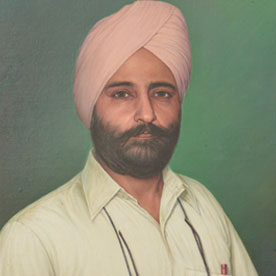

M.S. (Ophthalmology), 1992: D.Sc. (Honorary)

Born: 11th Oct.1934.
Education: Daljit was enrolled at Khalsa School. After encouragement from a family member who was a medical doctor, he began studying to become one as well. He was pre-medical at Khalsa College, then graduated in medicine with a MBBS from the Government Medical College, Amritsar in 1956. After receiving his Bachelors of medicine and surgery, he performed a "house job" in ophthalmology and earned an ophthalmic diploma (DOMS). After working for atwo years, he earned a masters degree (MS) in ophthalmology in 1963.
Professional experience: Pharmacology and Physiology teacher: 1.5 years.
In the field of Ophthalmology: 54 years. Rural service 2.5 years. On the faculty of Medical College Amritsar and Patiala: 23 years. Professor emeritus since 1986. Running Daljit Singh Eye Hospital,Amritsar, well known since 1985, where no patient is ever turned away for lack of funds.
Honours received:1987: Padma Shri,1990: Shromani Lekhak Award by Language Department Punjab. 1992: Doctor of Science (Honorary) Guru Nanak Dev University.1994 : Fellow, National Academy of Medical Sciences.1994: B.C.Roy Award.1996: World Eye Foundation Hampton Roy Award.1998: American College of Eye Surgeons – John Sheet Lecture.1999: Fellow, Punjab Academy of Sciences.1999: Punjab Ratan Award.2011: “Global Icon”: Intraocular Implant and Refractive Society of India.2013: “Award of Honour” by Association of Community Ophthalmology,India. 2013: “Lifetime Achievement Award” Bombay Ophthalmology Association.
Professional Publications:1.The Applications of Fugo Blade (2010) By Lippincots, USA.2.Cataract & IOL (1993) Published by Jaypee Bros New Delhi. 3.Intraocular Lens (Editor) 1981, Published by Praeger, New York. Fourteen chapters in different Ophthalmic specialty books dealing with Pediatric cataract, Iris claw lenses, Phakic intraocular lenses, Congenital cataract, Glaucoma and Fugo blade applications. Five chapters in Ophthalmology section of emedicine.com. Presentations at National and international conferences: Almost 300..
Membership of Societies: Founder President:Indian Intraocular Implant & Refractive Society, 1982 to 1991.Past President , All India Ophthalmology Society, 1996. International Intraocular Implant Club,first member from India since 1978.
Editorial Board:Chief Editor, Tropical Ophthalmology, the journal of Punjab Ophthalmology Society, since 1999.Formerly,Associate Chief Editor, Annals of Ophthalmology (USA).
Intraocular lens implants:First to introduce lens implantation for cataract cases in India in 1976.Introduced Singh-Worst iris claw lens in 1979, now accepted world wide. It was introduced in the USA, 18 years later. He has the largest experience in the world with iris claw lens. Operated on the President of India in 1985, with this very lens.Trained over 450 eye surgeons from all parts of India with intraocular lens techniques. This brought about lens implant revolution in India.Known as father of implant surgery in India.
Glaucoma: Developed many new techniques of glaucoma surgery.1.Pre-trabecular Filtration (1978), UK Ophthalmology Society.2.Transciliary filtration for intractable glaucoma (1979), Ophthalmology Society of UK, .3.Microtrephine operation for glaucoma.(1986) International Congress of Ophthalmology.4.Trans-ciliary filtration using Fugo plasma knife (2001), 4.Micro-track filtration (2004): Using Fugo blade, it is the least traumatic operation for glaucoma. First in India to use “cross linked sodium hyaluronate”in glaucoma surgery.
Keratoprosthesis: Developed artificial cornea called Singh-Worst keratoprosthesis in 1979. Singh Paralimbal keratoprosthesis technique (1981) This surgery is done in those corneal blind patients, that are unfit for cornea graft surgery.In this field, he and his institution has the largest and longest experience in the world.
Ptosis (drooping lids): The available techniques run the risk of corneal dryness and inability to close the operated eye. He has designed two new techniques that are free from these defects. They are: 1. Orbicularis oculi plication (1996),2. Plication of levator palpebrae superioris from the upper fornix (2004).
Refractive lens surgery: To treat high refractive errors. Using iris claw lens he was the first in the world to treat phakic high hypermetropes.
Laser Refractive Surgery-To remove the spectacles number, he was the first to introduce this surgery in India (1991). First in the world to use laser refractive surgery in the young patients (1994). Most experienced in the world to treat high to very high myopia.
Fugo plasma blade Applications: First in the world to use this plasma energy in eye surgery (1999).It has been pioneered and extensively used by him and his institution in cataract, glaucoma, strabismus, oculoplastic and vitreo-retinal operations.
Conjunctival and corneal lymphatic system: He discovered the system of lymphatics (2000), hitherto unknown to the eye surgeons of the world. He charted extensive conjunctival lymphatic system. This was followed by the discovery of channels in the cornea. He also discovered that the so called “lucid interval” in the corneal periphery is actually a lymphatic channel. Now it is “Singh Canal”.
The genetics of congenital cataract: Working with Guru Nanak Dev University, he has discovered 9 out of 22 known genes of congenital cataract.
3D still photography of the eye (1993). 3D Videography of eye surgery first time in India, since 1995, that he uses for teaching fine points in ophthalmic surgery.
Even at the age 82 years, he continued to operate, examine and research for 10 hours, every day of the year before his demise on 27th of December 2017.